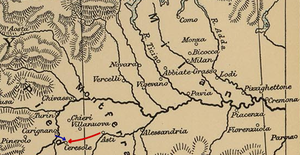Battle of Ceresole
| Battle of Ceresole | |||||||
|---|---|---|---|---|---|---|---|
| Part of the Italian War of 1542–46 | |||||||
 Movements before the battle; the Imperial advance from Asti is shown in red and Enghien's march from Carignano in blue. |
|||||||
|
|||||||
| Belligerents | |||||||
|
|
|
||||||
| Commanders and leaders | |||||||
|
|
|
||||||
| Strength | |||||||
| ~11,000–13,000 infantry, ~1,500–1,850 cavalry, ~20 guns |
~12,500–18,000 infantry, ~800–1,000 cavalry, ~20 guns |
||||||
| Casualties and losses | |||||||
| ~1,500–2,000+ dead or wounded | ~5,000–6,000+ dead or wounded, ~3,150 captured |
||||||
The Battle of Ceresole (or Cérisoles) took place on 11 April 1544, during the Italian War of 1542–46, outside the village of Ceresole d'Alba in the Piedmont region of Italy. A French army, commanded by François de Bourbon, Count of Enghien, defeated the combined forces of the Holy Roman Empire and Spain, commanded by Alfonso d'Avalos d'Aquino, Marquis del Vasto. Despite having inflicted substantial casualties on the Imperial troops, the French subsequently failed to exploit their victory by taking Milan.
Enghien and d'Avalos had arranged their armies along two parallel ridges; because of the topography of the battlefield, many of the individual actions of the battle were uncoordinated. The battle opened with several hours of skirmishing between opposing bands of arquebusiers and an ineffectual artillery exchange, after which d'Avalos ordered a general advance. In the center, Imperial landsknechts clashed with French and Swiss infantry, with both sides suffering terrific casualties. In the southern part of the battlefield, Italian infantry in Imperial service were harried by French cavalry attacks and withdrew after learning that the Imperial troops of the center had been defeated. In the north, meanwhile, the French infantry line crumbled, and Enghien led a series of ineffectual and costly cavalry charges against Spanish and German infantry before the latter were forced to surrender by the arrival of the victorious Swiss and French infantry from the center.
Ceresole was one of the few pitched battles during the latter half of the Italian Wars. Known among military historians chiefly for the "great slaughter" that occurred when columns of intermingled arquebusiers and pikemen met in the center, it also demonstrates the continuing role of traditional heavy cavalry on a battlefield largely dominated by the emerging pike and shot infantry.
...
Wikipedia
